In This Issue...
*
F.I.D.O.: Marit Holm
*
Nunavik Dog Slaughters, Part III
*
Greenland Dog / Inuit Dog, The Same Dog
*
Differences in Mushing: Greenland and Arctic Canada, Part I
*
Fan Mail
*
Behavior Notebook: The Human Role
*
Book Review: Frozen Horizons
*
Product Review: Wheel Dog Harness
*
Tip for the Trail: Pack a Pruning Saw
*
IMHO: The System
*
Annual Index for Volume 7
Navigating This
Site
Index of articles by subject
Index
of back issues by volume number
Search The
Fan Hitch
Articles
to download and print
Ordering
Ken MacRury's Thesis
Our
comprehensive list of resources
Talk
to The
Fan Hitch
The Fan
Hitch home page
ISDI
home page
Editor's/Publisher's Statement
Editor: Sue Hamilton
Webmaster: Mark Hamilton
The Fan Hitch welcomes your letters, stories, comments and suggestions. The editorial staff reserves the right to edit submissions used for publication.
Contents of The Fan Hitch are protected by international copyright laws. No photo, drawing or text may be reproduced in any form without written consent. Webmasters please note: written consent is necessary before linking this site to yours! Please forward requests to Sue Hamilton, 55 Town Line Rd., Harwinton, Connecticut 06791, USA or mail@thefanhitch.org.
This site is dedicated to the Inuit Dog as well as related Inuit culture and traditions. It is also home to The Fan Hitch, Journal of the Inuit Sled Dog.
by Sue Hamilton
Folks generally understand the difference in configuration between the tandem 'Nome-style' hitch and a fan hitch. But many may not know that the Greenlandic and arctic Canadian fan hitches are distinctly different. In Greenland majority of the traces are of equal length, while one to perhaps four are longer but still of equal length to each other. In Canada, the tugs vary considerably in length with only one the longest.
Canadian-style fan hitch
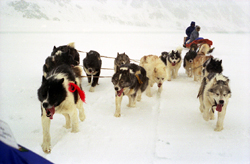
Only one lead dog, with the decorated
harness
Greenlandic-style fan hitch
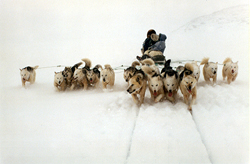
Note there are four lead dogs
How the traces attach to the sled differs as well. In Greenland, each tug line has a knot at its end. Ends of the traces are bunched together, then the musher loops the sled's bridle around those bundled traces to secure the team to the sled. The loop can be easily undone to untangle the "braid" that is created as dogs change places within the team (which restricts freedom of movement), but not so easily undone that when the dogs stop the connection unravels on its own. The arctic Canadian bridle is a little more elaborate, yet also with no moving parts or clasps. Each tug has a sewn loop at one end and a fastening ring at the other. The loop end attaches to a toggle sewn into the back of the harness while the bridle line passes through the fastening ring at the other end of the tug and then is secured to itself with another toggle and loop. In the old days toggles and rings were made out of bone and or ivory. Today they are fashioned out of left over pieces of the same thick plastic used on the bottom of the sled runners, and they still incorporate the advantage of no moving parts to break or fail. (See "Raising Sled Dogs" The Fan Hitch, August 2000, V2, N4 )
Canadian-style bridle
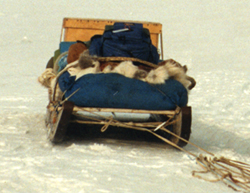
Greenlandic-style bridle
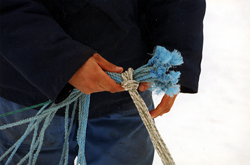
Greenlandic and Canadian sleds exhibit a number of differences, too. Although both are similarly constructed of thick dimensional lumber (I have also seen one with aluminum runners) to withstand punishing conditions, the Greenland sled has what we "woodland mushers" would refer to as a "driver's bow", only occasionally seen on Canadian qamutiit. Greenlanders can stand on the extremely short runner extensions while holding on to the upright section, to help steer and to literally dig in their heels as a way to slow down. There is no mechanical brake of any kind. Sometimes, the Greenland sleds are brightly painted (as seen in this issue's F.I.D.O.). The average sled length in Greenland is shorter than the average length found in arctic Canada, although size varies with purpose.
Canadian-style qamutiq
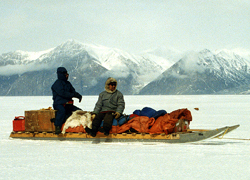
Note the aluminum runners
Greenlandic-style qamutiq
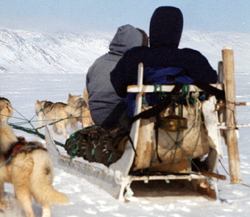
This sled is smaller and not as heavily
loaded as the
one above
because the travelers are staying in
wooden huts
and therefore
donít need to carry as much
gear
All photos: Hamilton